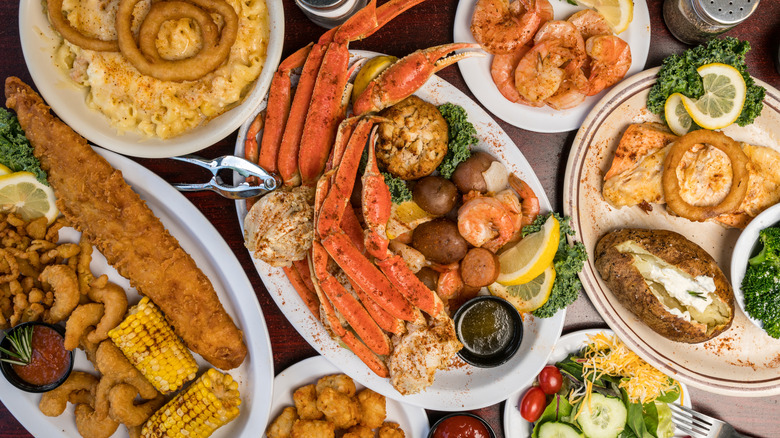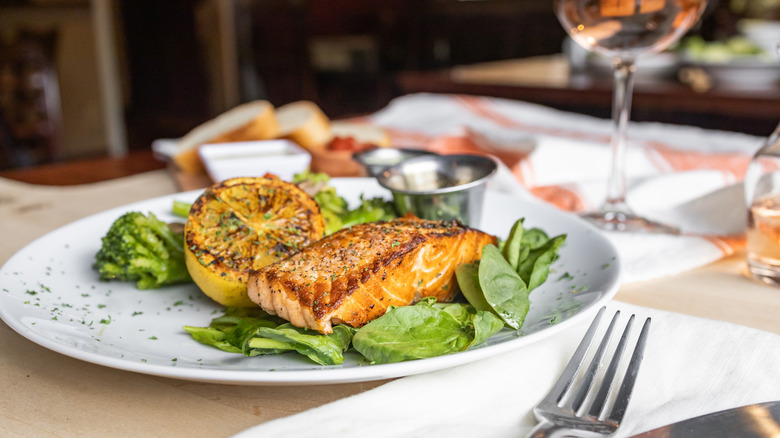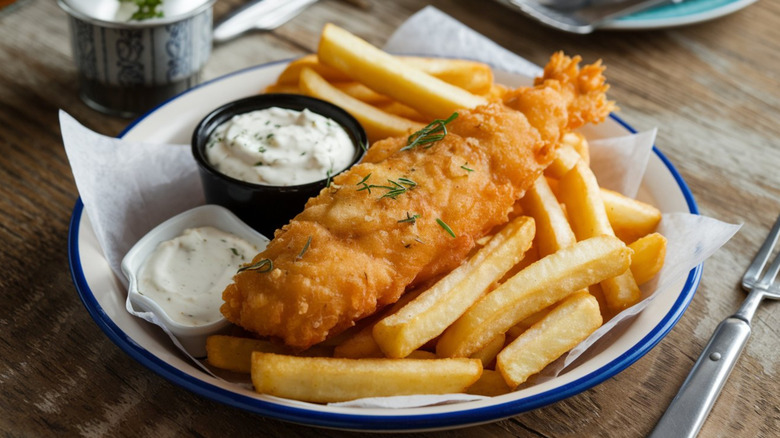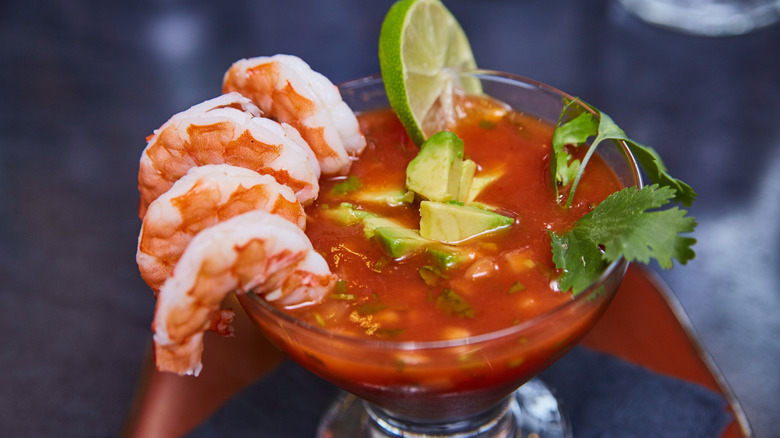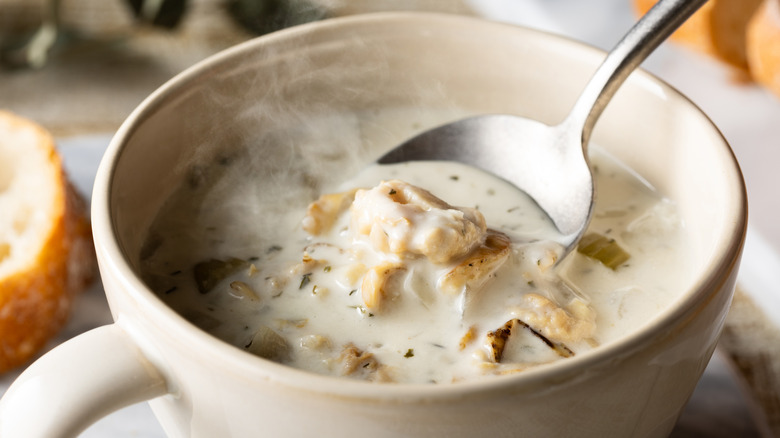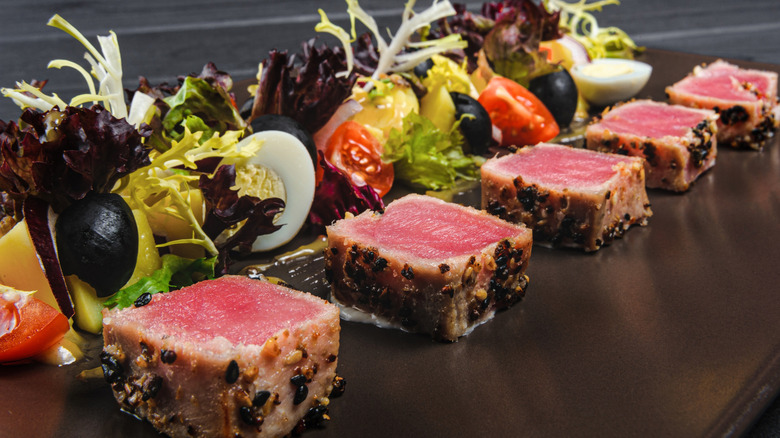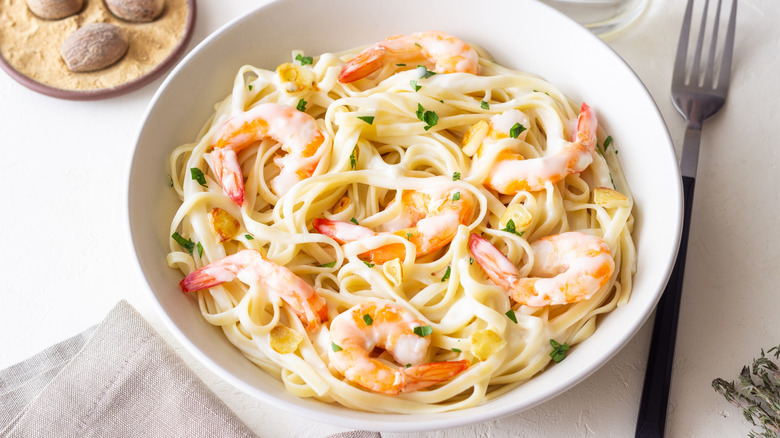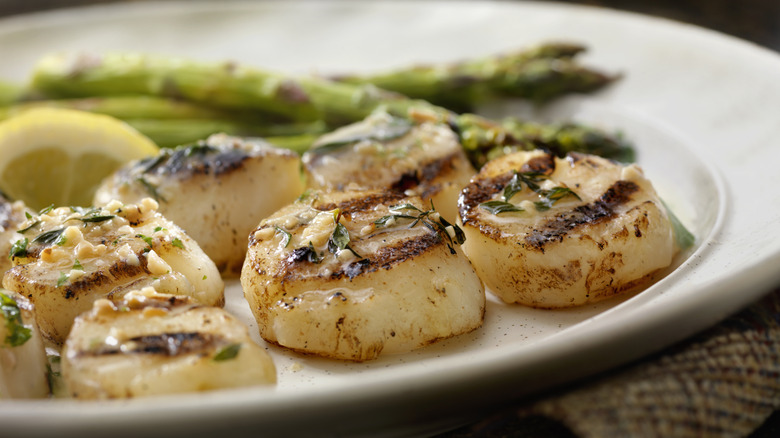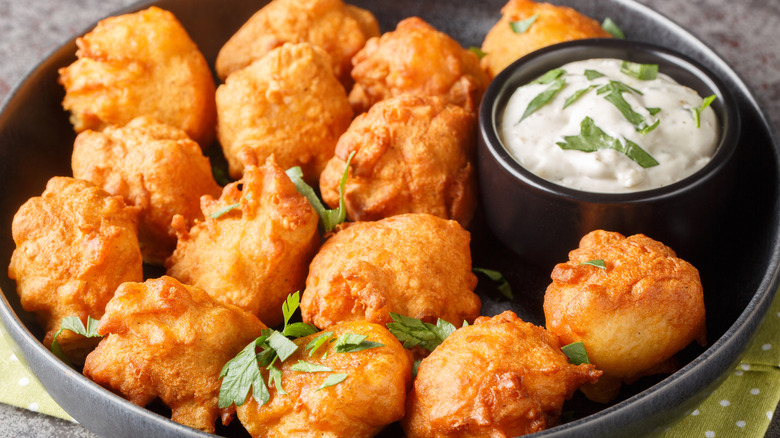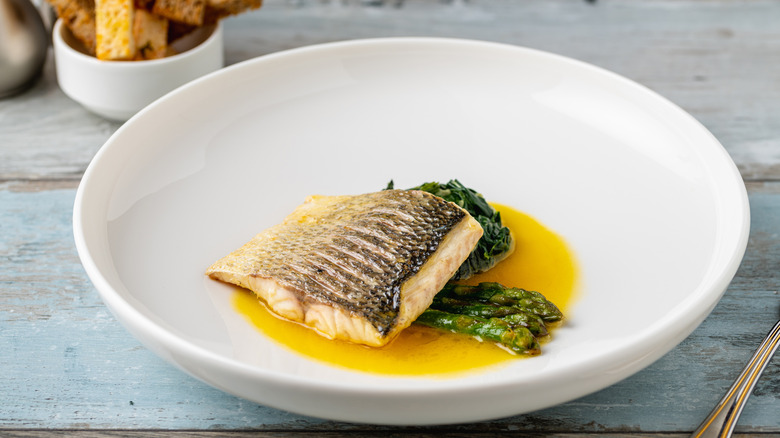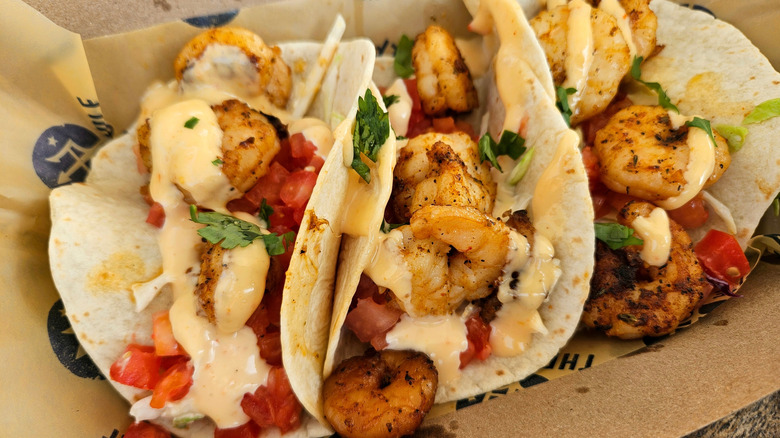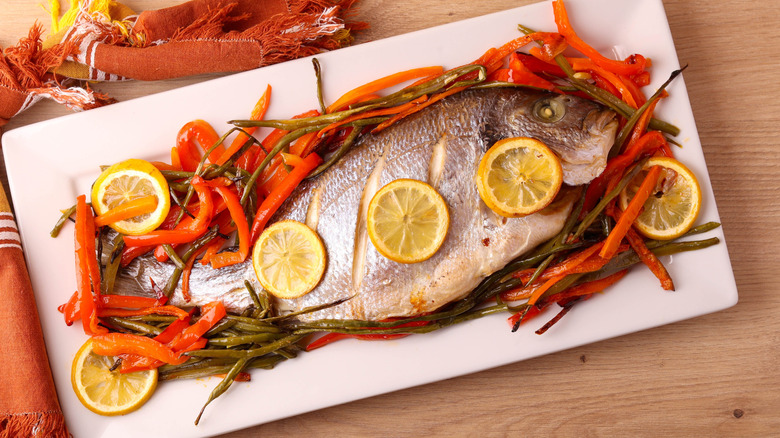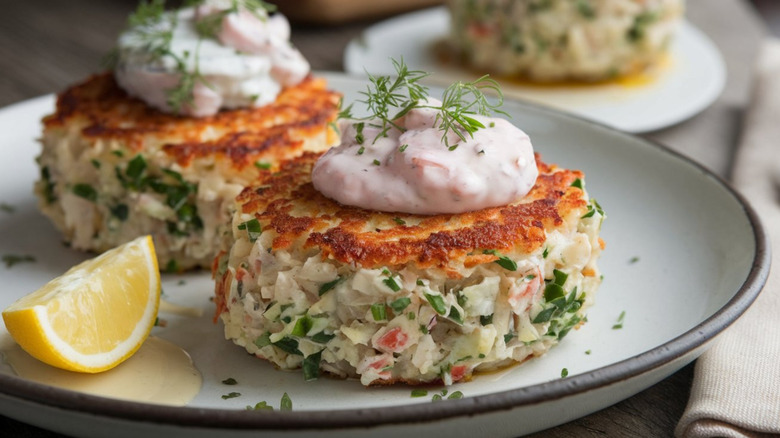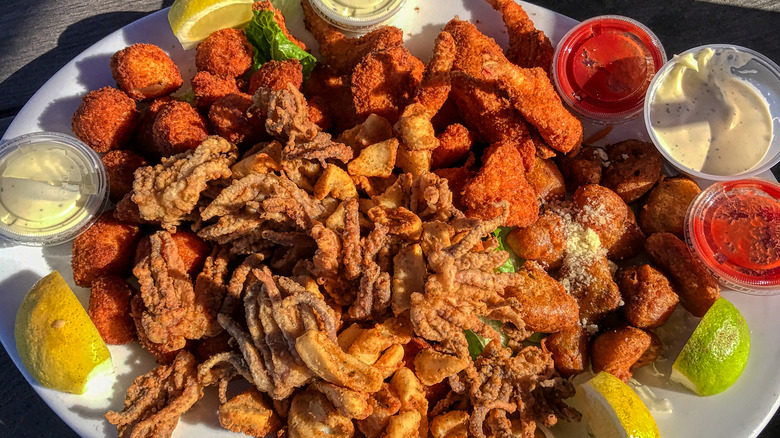6 Healthiest And 7 Unhealthiest Things To Order At A Seafood Chain
Sometimes, nutrition is the last thing on our mind when we go out for seafood. Even if it's at some big chain restaurant — especially for land-locked folk who have it near impossible to come across fresh seafood — going out for fish and marine products carries an air of novelty that makes those calories listed in parentheses more of an unwelcome nuisance than helpful guide. Plus, many restaurants don't provide an additional nutritional breakdown (or any breakdown whatsoever), and we know it's not quite as simple as "more calories equals bad, less equals good."
The actual important consideration is which meals will leave you satisfied and full of energy, and which will leave you with a food coma in the booth after signing the check. Avoiding fried fish and seafood (or at least eating them in moderation) is an easy first step in determining a healthier order, but many other menu items are unhealthier than you'd expect, and sneak in exorbitant levels of fat and sodium.
If asking your waiter for the healthiest option is a phrase you'd rather avoid when ordering fish, we've done the deep-sea dive for you and taken a look at which patterns emerge between some of the nation's biggest seafood chains. From fast food chains like Long John Silver's, mid-range restaurants like Red Lobster, to higher-end joints like Eddie V's Prime Seafood, check out some of the healthiest and unhealthiest items on the menu below.
Healthiest: Grilled salmon
Although there are many different types of salmon, the Atlantic variety is the most common choice you'll find served up at your favorite seafood chain. Atlantic salmon encompasses one single species, including the Norwegian-imported options from restaurants like Legal Sea Foods or Eddie V's. Pacific salmon — a lot of which comes from Alaska — is actually broken down into several varieties depending on fat content and geographical location. Since Pacific salmon is typically wild-caught, it may be more expensive and harder to come across at a chain.
Whichever type you order, however, rest assured it's a win nutritionally. The meaty, pink fish is packed with protein and nutrients like B vitamins and omega-3 fatty acids. These essential fats can help keep your heart healthy and have even been linked to anti-inflammatory properties. And don't skip out on the skin – salmon skin is one of the most nutrient-dense parts of the fish.
In order to reap all of the salmon's health benefits, look for keywords on the menu like grilled, blackened, or broiled. In fact, Red Lobster's salmon entrées are some of the healthiest picks on the menu, with each plate delivering around 500 calories and 600 milligrams of sodium. Just steer clear of salmon plates that are smothered in sweet or salty marinades, which could send sugar and sodium levels through the roof.
Unhealthiest: Fish and chips
Hopefully fish and chips landing on the unhealthy side of our list comes as no surprise — it is a basket of fried fish and french fries, after all. While we should feel free to enjoy these tasty and comforting meals in moderation, it's important to consider how eating too much fried food can affect our bodies. Fish and chips usually features cod – a mild, white, and flaky fish with plenty of lean protein and nutrients. Dredged in coating and fried in oil, however, any health benefits are pretty much tossed overboard.
Additionally, the process of frying food skyrockets the amount of calories and can create artificial trans fats. These fats are difficult for our bodies to break down and could increase the risk for cardiovascular issues. Artificial trans fats develop when unsaturated fats are exposed to high heat — like when frying — so it doesn't help that many seafood chains probably opt for cheaper frying oils that are higher in unsaturated fats.
A basket of the Captain's fish & chips from Bubba Gump, for example, packs 1,140 calories per serving. While the Forrest Gump-inspired chain doesn't provide a detailed nutritional breakdown, a similar basket from Bonefish Grill contains 66 grams of fat and 2,350 milligrams of sodium. For reference, the American Heart Association recommends a maximum of 2,300 milligrams of sodium per day.
Healthiest: Shrimp cocktail
Aside from being a little fancy and a great way to spur an appetite, the best thing about shrimp cocktail is its simplicity. While the shellfish are small, they're also low in calories and mighty in nutrients, antioxidants, and protein. Unlike popcorn shrimp, coconut shrimp, or Bonefish Grill's Bang Bang shrimp, a shrimp cocktail allows you to relish all of the crustacean's health benefits without a lot of distractions.
Although it is served cold, shrimp cocktail is never served raw. Rather, the shrimp are poached or boiled to ensure food safety, then left to cool before serving over ice with the classic cocktail dip. Considering the tangy dip is a mix of ketchup, horseradish, and Worcestershire sauce, this may be the one component where you should practice some restraint, to avoid consuming more sodium or sugar than planned.
Another important consideration with our favorite shellfish is where it's sourced. The FDA cannot feasibly inspect all the shrimp imported into the U.S., meaning some crustaceans may slip in that have been treated with antibiotics from countries with fewer regulations. It's not always easy to find out where your seafood comes from at a chain restaurant, but keywords like wild-caught or U.S.-sourced can indicate your shrimp is antibiotic-free. Notable examples include the wild gulf shrimp from Eddie V's, or the shrimp from Legal Sea Foods, which was awarded four stars by Best Aquacultural Practices.
Unhealthiest: Clam chowder
If you can't quite put your finger on what makes restaurant food taste a little better than what you whip up at home, the answer is butter and salt. Anthony Bourdain once famously wrote that you should assume you've downed about one stick of butter after leaving a good restaurant — but while it's undoubtedly delicious, it is nutritionally dubious. Creamy chowders on the menu at seafood chains are often a red flag, packing enough butter, salt, and half-and-half to make you clam up.
Just one cup of chowder at Red Lobster delivers 260 calories and 14 grams of fat, amounting to 35% of the daily recommended intake of fats. Similarly, a cup at Joe's Crab Shack contains 250 calories and 930 milligrams of sodium. Compare this to the American Heart Association's recommended goal of 1,500 milligrams of sodium per day. Another consideration is that the clam chowder is probably just your starter or side dish, meaning there's more to pile on top of these figures. If you're looking for a healthier swap for something rich and cozy, look for tomato-based soup specials, like a Manhattan clam chowder. (And ignore any ensuing side eyes from diehard New Englanders.)
Healthiest: Ahi tuna
Unlike albacore tuna that's shredded and canned, Ahi is the Hawaiian term for the yellowfin species, which you'll often see in the freezer aisle as thick red steaks of the fish. Yellowfin tuna has become an increasingly popular and versatile option at seafood restaurants, typically served in straightforward preparations that let the fish show off its mild and meaty flavors, like in sashimi, poke bowls, or tacos. Most Ahi tuna is wild-caught by deep-sea fishing in the Pacific Ocean, so it's also a sustainable choice under no current threat of overfishing.
Nutrient-packed Ahi tuna contains lots of lean proteins and very little sodium or saturated fats. The Ahi tuna tartare at Eddie V's, for example, has 530 calories and 790 milligrams of sodium, with much of the sodium coming from the sriracha and vinaigrette seasonings. While the tartare has 25 grams of fat, keep in mind these are healthier sources of fat — from the avocados in the dish and omega-3s in the tuna — as opposed to, say, the fat in a fried crab rangoon.
Since it's often served raw, you'll also want to trust the establishment where you're enjoying your Ahi tuna. Truluck's – an upscale seafood chain — expresses its commitment to following the Ocean Conservancy guidelines, and is forthright about where your fish comes from. The chain offers sesame-seared Ahi tuna on the menu, which you can also order "simply prepared" to avoid additional sodium or sugars.
Unhealthiest: Seafood linguine
Pasta served with fresh clams, mussels, or shrimp with a drizzle of olive oil and splash of lemon has lots of nutritional potential, but many chains completely miss the mark. Creamy linguine dishes are one menu item best avoided at seafood restaurants, thanks to gooey sauces that smother the simple possibilities of the dish and can hide an abundance of calories, fat, and sodium. Plus, we do question if the sauce is meant to cover up some lack of quality ingredients or flavor. Take a look at Bonefish Grill's menu, for example, and the creamy tomato linguine with shrimp hits you with a tsunami of 1,700 calories, 50 grams of fat, and over 2,500 milligrams of sodium. You might need a long nap after putting back one of these pasta plates, if not a check-up with the doctor. Red Lobster's shrimp scampi linguine doesn't look much better, delivering 1,000 calories, 60 grams of fat, and over 2,000 milligrams of sodium.
For a healthier alternative, it might be worth shelling out a little more money at a higher-end seafood chain like Legal Sea Foods. Order the clams and linguine dish with a straightforward sauce of white wine, chili flakes, and pancetta.
Healthiest: Grilled scallops
Scallops are one of the healthiest seafoods, and that's not just because they're plump-full of lean protein and omega-3 fats. The tasty bivalve also delivers a wealth of nutrients in a bite-sized package, including iron, vitamin B12, and selenium –– a mineral with antioxidant properties that can also support immune health. Before ordering them off the menu, though, watch out for words like creamy, buttery, or fried, which could cancel out the seafood's simple goodness. It wouldn't hurt to scan the listed ingredients for anything suspicious, either. That means you might want to skip the bacon-wrapped scallops at Red Lobster, which deliver 350 milligrams of sodium per piece. Customers admit that these are leagues away from the best scallops you can order at a chain restaurant, anyway.
Instead, try the scallop skewers with citrus dressing at Bonefish Grill, with 400 calories and 510 milligrams of sodium per four pieces. If you're feeling a little fancier, you could splurge on the George Banks scallops with lemon butter at Eddie V's Prime Seafood, a chain that prides itself on fresh products and is comparable to the quality found at non-chain seafood joints. These North Atlantic scallops contain 200 calories and 490 milligrams of sodium per three pieces.
Unhealthiest: Hush puppies
Maybe the hush puppies are calling to you off the menu like sirens in the distance, but this fun side option is unfortunately a pretty unhealthy one. It doesn't help that the fried cornmeal balls are about as addictive as mindlessly munching your way through a bucket of popcorn. Even if they are filled with trace bits of onion, pepper, or corn, the veggies don't stand much of a nutritional chance against the deep-fried batter. Just one hush puppy at Captain D's – a fast-casual seafood chain with more than 500 locations in the U.S. — has 80 calories and 200 milligrams of sodium.
Swinging through the drive-thru at Long John Silver's and picking up a side of the traditional Southern snack is even worse, seeing as each hush puppy contains about 95 calories and 220 milligrams of sodium. (And that's without the tartar sauce.) Even the waffle fries at the fast food chain are a slightly less sodium-laden option, delivering 160 milligrams per entire serving. If you've been planning to chow down after finding out that Red Lobster is reintroducing hush puppies on its menu, just know they're nutritionally about the same as any other chain. It might not hurt to satisfy the craving by splitting an order with a group of friends.
Healthiest: Grilled sea bass
Sea bass is often one of the most simply-prepared dishes you can order at a seafood chain, although you might find it listed under a few different names. Chilean sea bass, for example, is the friendlier name for a flaky, white fish that's not even a bass at all, but a Patagonian toothfish. When American wholesalers discovered its buttery flavors in the 1970s, they decided to "rebrand" it with a name that sounded a bit more appetizing.
The Chilean sea bass is caught from the tip of South America to Antarctica, while the European sea bass – or branzino — swims in the warmer waters of the Mediterranean (although it's increasingly farm-raised in the U.S., too). Thanks to its firm meat and thin skin that crisps up nicely, European sea bass is typically served whole, especially in Italian and Greek cuisines.
Even if the idea of a fish staring up at you from the plate is too much to bear, the health benefits are worth overcoming your fears. These different types of sea bass are tender, rich, and full of omega-3 fatty acids, meaning they can stand up to various cooking techniques and don't need much fuss to taste delicious. Eddie V's Prime Seafood offers a Mediterranean branzino that has only 560 calories and packs 57 grams of protein. The chain also has a grilled Chilean sea bass plate that, albeit higher in sodium, contains only 290 calories and 42 grams of protein.
Unhealthiest: Seafood tacos
If you're trying to make healthier choices when going out to eat, seafood tacos probably sound like a pretty safe bet. It's just your seafood of choice, taco shells, and some fixins, right? The answer would be yes in an ideal world, or if you prepare them yourself at home and have control over the seasonings and additions. At many chain restaurants, however, with extras like zingy sauces and fried seafood, tacos are often a deceptively unhealthy menu option.
At Bonefish Grill, three signature Bang Bang shrimp tacos – without any fries, just coleslaw — deliver a whopping 1,200 calories, 85 grams of fat, and 3,200 milligrams of sodium. Sure, you could blame those figures on the saucy, fried shrimp, but even three blackened Baja fish tacos with slaw have 1,260 calories, 84 grams of fat, and 3,830 milligrams of sodium. Considering these tacos just contain Baja fish – which is typically cod or halibut — tomatoes, lettuce, chimichurri, and a cilantro lime sauce, it's not entirely clear how the nutrition facts pile up so egregiously.
Healthiest: Mahi mahi
Hawaiian for very strong, mahi mahi is a type of fast-swimming white fish that's wrangled its way onto the menus of even the most conventional seafood chains. Also known as dolphinfish or dorado (Spanish for golden), mahi mahi usually hang out in warmer waters and can grow to sizes of over 100 pounds. Those that are caught by U.S. fisheries are also considered a sustainable catch by Monterey Bay Aquarium Seafood Watch.
On its own, the fish is low in fat, mercury, and sodium, while boasting high levels of proteins, nutrients, and B vitamins. What makes mahi mahi an especially healthy choice is that most restaurants offer it as a very simple preparation, without fried batters or sodium-laden sauces. Some of the healthiest options at Red Lobster, for example, include the mahi mahi either blackened, broiled, or grilled. At Bubba Gump, the cajun-spiced mahi mahi comes with shrimp, onions, tomatoes, and mashed potatoes, ringing in at only 750 calories.
Unhealthiest: Crab cakes
A simple toss of crabmeat, mayo, mustard, and some bread crumbs, crab cakes are a Chesapeake Bay classic that have become a menu staple at plenty of seafood restaurants. Crabmeat is loaded with protein and omega-3 fatty acids, but depending on how the restaurant serves them up, crab cakes can lose most of their nutritional variety to deep-fat frying. Some of the best chain restaurant crab cakes will be baked or broiled, but our favorite fast food or casual joints usually stick to frying. While the fried cakes undoubtedly make for a tasty coastal snack, the high levels of calories and sodium represent a particularly unhealthy choice.
One crab cake from Long John Silver's, for example, delivers 280 calories and 450 milligrams of sodium. This may not look so bad on its own, but the figures seem to skyrocket as soon as you add the cakes to another meal. At Joe's Crab Shack, the highly nontraditional crab cake chipotle Caesar salad amasses 980 calories and 2,670 milligrams of sodium. Or, the crab cake dinner — which is just the cakes with white rice and veggies – somehow totals around 1,500 calories and 3,420 milligrams of sodium.
Unhealthiest: Seafood feasts and platters
If you're dining out with a group of friends (or you've just worked up an incredible appetite), ordering the seafood platter might sound like a tempting offer. These feasts typically include a hefty variety of items off the menu, so you're left with the impression that you're getting a good deal and the chance to sample a little of everything. Unfortunately, you're usually not getting a heaping tray of steaming, fresh-caught crustaceans, like in a seafood boil. Rather, many platters are simply piled with fried, poor-quality marine products that leave the entire meal remarkably devoid of any nutrition. For the healthiest dishes, you should look for quality over quantity, and don't disregard color, either. A plate with varying shades can represent a diverse nutritional profile, opposed to the seafood feast that's overflowing with a single deep-fried golden brown.
At Captain D's, the ultimate seafood platter comes with lobster bites, fried shrimp, and stuffed crab shells, delivering 81 grams of fat (4 ½ grams of which are trans fats) and 2,670 milligrams of sodium. Similarly, Red Lobster's Admiral's feast comes with an abundance of fried scallops and clam strips, amounting to 99 grams of fat and almost 5,000 milligrams of sodium.
